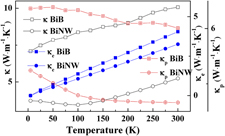Article contents
Electronic structure, lattice dynamics, and thermoelectric properties of bismuth nanowire from first-principles calculation
Published online by Cambridge University Press: 16 March 2017
Abstract

To reveal the electron and phonon transport mechanism in bismuth nanowire (BiNW), the electronic structure, the lattice dynamics, and the thermoelectric properties of bismuth bulk (BiB) and BiNW were investigated in this paper through first-principles calculation and the Boltzmann transport theory. The results suggest that BiNW possesses an increased electrical conductivity and Seebeck coefficient, while its thermal conductivity, especially phonon thermal conductivity, is reduced significantly as compared to BiB. As a consequence, a largely enhanced figure of merit (ZT) at 300 K of 2.73 is achieved for BiNW. The enhancement in electrical conductivity and Seebeck coefficient of BiNW is originated from its high density of states and large effective mass of carriers. Such significant suppression in phonon thermal conductivity of BiNW is ascribed to the reduced phonon vibration frequency, the decreased phonon density of states, and the shortened mean free path of phonons. So BiNW should be viewed as an excellent candidate for a thermoelectric material with a high figure of merit. Moreover, we have provided a complete understanding on the relationship between the electronic structure, the dynamics, and the thermoelectric properties of BiNW.
- Type
- Articles
- Information
- Copyright
- Copyright © Materials Research Society 2017
Footnotes
Contributing Editor: C. Robert Kao
A previous error in this article has been corrected, see 10.1557/jmr.2017.240.
References
REFERENCES
A correction has been issued for this article:
- 3
- Cited by
Linked content
Please note a has been issued for this article.



